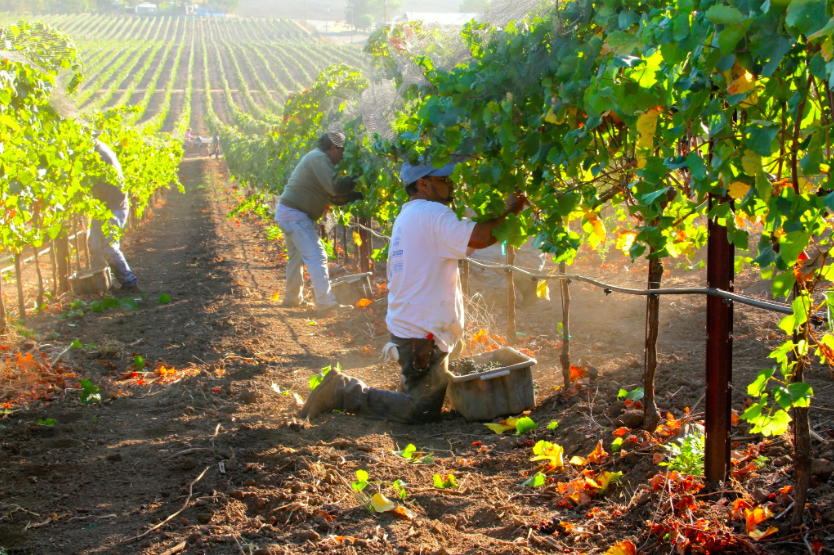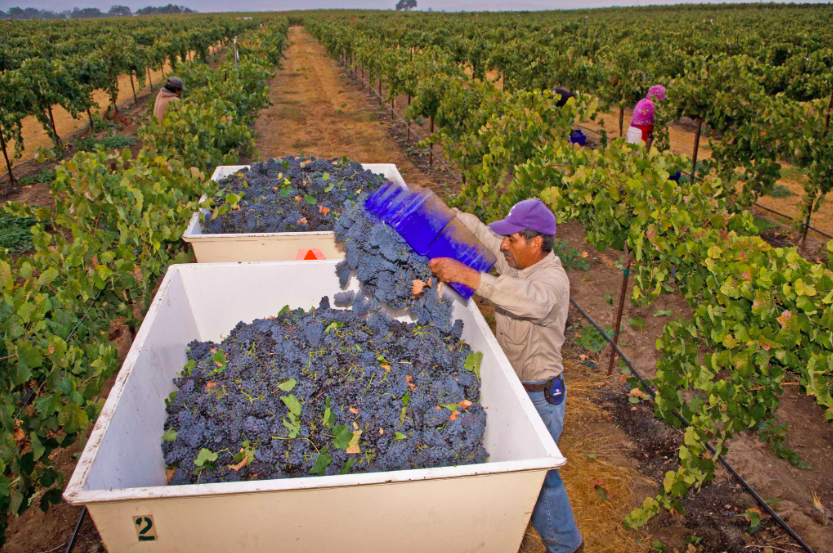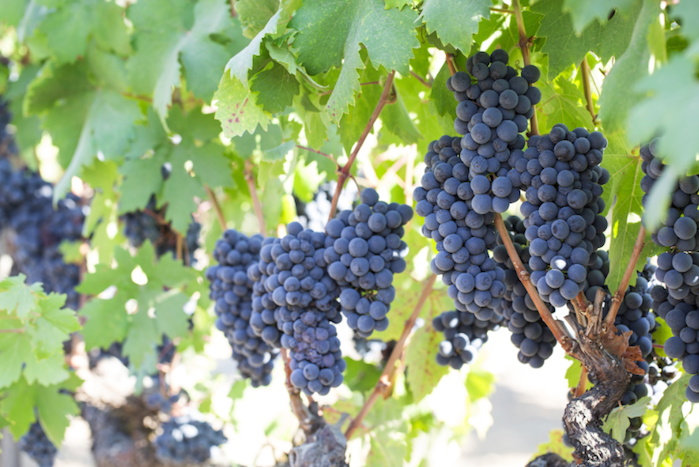Despite wildfires that swept through parts of the state, California winemakers remain optimistic about their 2017 harvest.
So says the Wine Institute in their recently released California Wine 2017 Harvest Report. The study explores the impacts of fires, rain and a late-summer heat wave on the harvest, while also detailing regional production. Here are three key takeaways:
1) Fire Damage Could Have Been Worse
Flames that ravaged northern California in October made for national headlines. The natural disaster took lives and destroyed many properties: a terrible toll that prompted a swell of charitable support.
For the wine community, the damage could have been worse. Regions most affected were Napa, Sonoma and Mendocino counties (which account for 12% of California’s winegrapes). Before the fires affected these areas, Napa and Sonoma had picked approximately 90% of their harvest, according to the report, while Mendocino had picked about 85%.
“The vast majority of California’s 2017 winegrape harvest was unaffected by the wildfires and the vintage promises to be of excellent quality,” says Robert P. (Bobby) Koch, president and CEO of Wine Institute, in the report. “The outpouring of support locally and from around the world for people in the impacted communities has been phenomenal. We are saddened by the loss of lives and homes and this will truly be remembered as a harvest of the heart.”
Not mentioned in the report but discussed in wine circles is that unpicked grapes affected by the fires were mostly premium fruit, left on the vine to ripen maximally. If there is a noticeable impact on the 2017 Northern California harvest, it may be in reduced numbers of high-end releases like top-shelf Cabernet Sauvignon. Though, of course, this remains to be seen.

2) Rainfall and Heat Waves Were a Double-Edged Sword
This year did bring some welcome weather with higher-than-normal rainfall. California had been amidst a five-year drought that affected recent vintages. The 2017 season opened with ample rain that “refilled reservoirs and replenished soils,” according to the report.
A heat wave in late August and early September sped the pace of harvest season. Then temperatures cooled later in September, according to the report, “slowing the harvest pace and allowing red grapes to ripen gradually.” Although the heat wave caused reduced yields in some areas of California, vintners are “reporting strong quality for the 2017 vintage.”
The rain was beneficial. “It helped bring new life to cover crops that had been parched after several years of drought,” says Steve Lohr, CEO, J. Lohr Vineyards & Wines. “It has been a good year for us, all in all, on the Central Coast. From the 30,000-foot perspective, I would say that these wines are going to show particularly nicely in their youth but will have the capacity to age.”
The rainfall also presented challenges. “Zinfandel got caught by spring rain during bloom and most of our Zinfandel sites are down in tonnage anywhere from 15% to 40%,” says Eric Baugher, chief operating officer and winemaker, Ridge Vineyards Monte Bello Winery. “It does appear that the Zinfandel vintage will be an extraordinary one, similar to 1999. I expect similar excellent quality out of Chardonnay since thef ruit had such great intensity of flavor from the petite-size clusters and berries.”

3) Different Regions Faced Different Issues
The Wine Institute’s report included a region-by-region analysis of the 2017 harvest. Here are key takeaways from the report’s notes:
Amador County/Sierra Foothills: The heat wave made this a challenging season. Zinfandel, Barbera, Syrah, Grenache and Mourvèdre fared well, and the region’s overall yield was smaller than normal.
Lake County: The late-summer heat wave had minimal impact on Lake County vineyards. Vintners we able to give the fruit longer hang time into the cooler days of October, and winemakers are very optimistic about the quality of this year’s generous yields.
Livermore Valley: Yields are average except for Chardonnay, which is down as much as 20% in some vineyards. Petite Sirah is showing very well and Cabernet Sauvignon quality is exceptional. This year’s grapes generally have higher acids and lower pH.
Lodi: Yields are down 10%-20%, but overall quality has been strong. Early season whites came in bright and fresh with good levels of acidity. Reds are showing good intensity and concentration.
Madera: Yields were up slightly due to the heavy rainfall. Stems and seeds matured at lower Brix than normal. High temperatures caused vines to shut down early. Red Bordeaux varieties fared well.
Mendocino: Pinot Noir, Cabernet Sauvignon and Zinfandel are looking great and yields should be around average. Chardonnay may be a little light.
Monterey: Yields were light to average. The fruit looks very good overall, with especially high quality in Pinot Noir, Chardonnay, Cabernet Sauvignon and Merlot — all showing rich flavors.
Napa Valley: Reduced yields are expected for some varieties due to discarding fruit damaged by heat and wildfires. The whites have bright, fresh flavors and the reds are intense and rich. Sauvignon Blanc, Pinot Noir and Zinfandel are showing especially good quality.
Paso Robles: Heat damage was seen throughout the region, with certain areas faring better than others. Even so, vintners are optimistic about quality. The fruit is showing great intensity, with lower Brix levels and higher acids than normal.
San Diego County: Overall crop yields were up by 25% with good to excel¬lent quality fruit. The 2017 vintage will be excellent for San Diego County wines.
San Luis Obispo: Chardonnay yields are a bit higher than average and Pinot Noir is just below. Both are showing good flavor development, with a little less acidity than usual.
Santa Barbara: Clusters were smaller than normal, resulting in yield reductions for Pinot Noir and Chardonnay. Yields were average to nearly 50% of normal.
Santa Clara Valley: With the cooler temperatures in September, the later-ripening varieties such as Cabernet Sauvignon and Petite Sirah could con¬tinue to evolve on the vine and deliver excellent quality grapes.
Santa Cruz Mountains: Some vineyards were affected more than others by the region’s significant heat wave, depend¬ing on microclimates and farming practices. Crop loads were very good and quality looks fantastic for the varieties that were able to ride through the heat spell — especially Cabernet Sauvignon.
Sonoma County: Because most of the fruit was picked prior to the October fires, vintners have a positive outlook on the 2017 wines, comparing the vin¬tage to 2003, 2013 and 2014. The fruit has excellent color, pronounced flavors and high quality across varieties.
Temecula Valley: The heat wave drove up sugar levels and stunted physi¬ological ripening in some varieties, but early whites looked very good and acid levels were higher than ex¬pected. Rhone, Italian and Portuguese varieties fared well, and quality was solid for the vintage overall.
Photo atop by Erin Malone, courtesy of the Wine Institute.
Kyle Swartz is managing editor of Beverage Dynamics magazine. Reach him at kswartz@epgmediallc.com or on Twitter @kswartzz. Read his recent piece What’s the Future of Barrel Aging?







[…] varietals like pinot noir and chardonnay looked good in 2017 — and were harvested before the fires — there was a lot of damage to Bordeaux varietals still hanging on the […]
Cline 2017 zinfandel, bold color, smooth , velvety taste,good buy